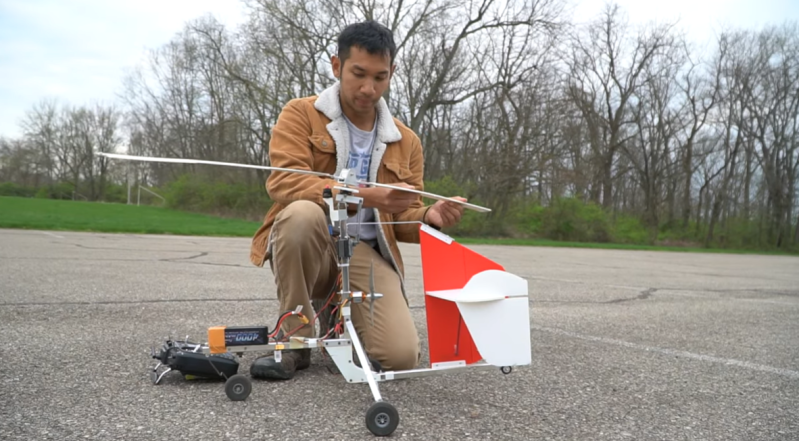Aviation consists of two major groups. Airplane enthusiasts, and helicopter enthusiasts. The two groups rarely get along, each extolling the virtues of their chosen craft. Somewhere in between are autogyro folks. People who like vehicles that blend the best (or worst) of both airplanes and helicopters. Aviation master [Peter Sripol] has dipped his toes into the autogyro world, but not without some trouble.
Autogyros are propelled by a propeller, like a plane. They also have a tail section that works similar to a fixed-wing aircraft. That’s where the similarities end though. Lift for autogyros comes in the form of a rotating set of blades, much like a helicopter. Autogyro rotors aren’t powered during flight. They utilize autorotation. The blades freewheel, spun by the air as the craft moves forward.
[Peter] recently got his hands on a full-scale autogyro. So it made sense to build a model to help learn to fly. This isn’t [Peter’s] first attempt with autogyro models. He’s built a few in the past, with limited success. This time he started from scratch and ran into even more problems!
[Peter] found that most autogyro models use gyroscopes to aid the pilot. These devices won’t be available on his full-scale ultralight, so [Peter] wanted to build a craft that flew without electronic assistance. His first designs resulted in crashes just after liftoff. [Peter] scaled the design up, because bigger models are always more stable in the air. He also found that aerodynamics don’t scale exactly to models, so some design changes were needed. Extending the tail finally gave him a stable craft, but it still had problems. Changes to the rotor head and blade design turned out to be the real keys to getting the model to work. The details are all available in this 49 page (and counting!) R/C Groups forum thread.
The nice thing about this model is that it’s not hard to build. Most of the frame is built from towel bars and aluminum bits you can pick up at the local hardware store. The blades are 3D printed with aluminum spars. [Peter] has promised to upload the design files by the end of May.
Curious about autogyros? We’ve covered models and full-scale versions right here at Hackaday.

















“not had to build” – not hard to build.
No….
I think we, HaD denizens, are forbidden to build them.
Worth noting the RCGroups thread was created by the creator of Mickey’s Big Timer: https://hackaday.com/2021/06/13/mickeys-big-timer-makes-glider-competitions-better/
As I recall, there were ads for autogyro kits or maybe plans in Popular Science and the like in the sixties. Not models, but things you could ride in.
Well they obviously didn’t take off.
I’ll get my coat.
Paragliding/Paramotor kits seem more popular these days. However, the $12k tandem-seat Gyroplane kits with rotor pre-spin-up clutch handle were still available last I checked. As with most ultralights/experimental-aircraft these are generally prohibited to fly over populated areas, so you will not see very many craft around even though they are relatively economical to own. The question of safety is little harder to answer. ;-)
Given his experiences with even model gyros having a tendency to turn over and crash spectacularly shortly after takeoff (usually he can get model aircraft to fly seemingly on in-thrust-we-trust) and you can understand why he doesn’t want to fly one of those until he knows the failure modes and how to recover from them.
I’d like to build a RC helicoper-autogyro hybrid someday. Something like Rotodyne.. have an option to fully power the main rotor but mainly to *have full cyclic control*.
Without full cyclic control an autogyro behaves much much more like a plane even though it may look much more like a helicopter.
Might be interesting to build an Autogyro with Tip Jets just to spice things up.
https://en.wikipedia.org/wiki/Tip_jet
Thanks for that link. I had never heard of Tip Jets before. I wouldn’t mind giving one a go (model of course, not full size).
Getting your thrustline right is super important on autogyros or they have a tendency to deposit you at the bottom of a crater if you goose the power when they’re slightly nose down.
Another issue that may be the culprit is that the torsional stability of the rotor blades is insufficient to keep the angle of attack of individual blades at the correct angle to the air stream. I saw that in later iterations, Peter had hinging to allow the blades to regress and progress as the blades rotate while flying forward under power. I had read a book, Frank T. Courtney’s “The Eight Sea” that went through the prototyping process with Juan de la Cierva as his test pilot that iterated the hinging, as well as the issues with the blade mounts on the rotor fatiguing due to the cycling loads under operation.